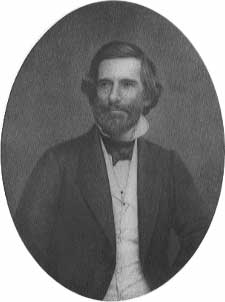Samuel Gridley Howe
|
|
Samuel Gridley Howe (November 10, 1801 - January 9, 1876) was a prominent 19th century United States physician, abolitionist, advocate of education for the blind, and husband of Julia Ward Howe.
Howe was born in Boston, Massachusetts. His father, Joseph N. Howe, was a ship-owner and cordage manufacturer; and his mother, Patty Gridley, was one of the most beautiful women of her day. Young Howe was educated at Boston and at Brown University, Providence, and in 1821 began to study medicine in Boston. But fired by enthusiasm for the Greek revolution and by Byron’s example, he was no sooner qualified and admitted to practice than he abandoned these prospects and took ship for Greece, where he joined the army and spent six years of hardship amid scenes of warfare. Then, to raise funds for the cause, he returned to America; his fervid appeals enabled him to collect about $60,000, which he spent on provisions and clothing, and he established a relief depot near Aegina, where he started works for the refugees, the existing quay, or American Mole, being built in this way. He formed another colony of exiles on the Isthmus of Corinth. He wrote a History of the Greek Revolution, which was published in 1828.
In 1831 he returned to America. Here a new object of interest engaged him. Through his friend Dr John D. Fisher (d.1850), a Boston physician who had started a movement there as early as 1826 for establishing a school for the blind, he had learnt of the similar school founded in Paris by Valeritin Hauy, and it was proposed to Howe by a committee organized by Fisher that he should direct the establishment of a “New England Asylum for the Blind” at Boston. He took up the project with characteristic ardour, and set out at once for Europe to investigate the problem. There he was temporarily diverted from his task by becoming mixed up with the Polish revolt, and, in pursuit of a mission to carry American contributions across the Prussian frontier, he was arrested and imprisoned at Berlin, but was at last released through the intervention of the American minister at Paris. Returning to Boston in July 1832, he began receiving a few blind children at his father’s house in Pleasant Street, and thus sowed the seed which grew into the famous Perkins Institution. In January 1833 the funds available were all spent, but so much progress had been shown that the legislature voted $ˇooo, later increased to $30,000 a year, to the institution on condition that it should educate gratuitously twenty poor blind from the state; money was also contributed from Salem, and from Boston, and Colonel Thomas H. Perkins, a prominent Bostonian, presented his mansion and grounds in Pearl Street for the school to be held there in perpetuity. This building being later found unsuitable, Colonel Perkins consented to its sale, and in 1839 the institution was moved to South Boston, to a large building which had previously been an hotel. It was henceforth known as the "Perkins Institution and Massachusetts Asylum (or, since 1877, School) for the Blind". Howe was director, and the life and soul of the school; he opened a printing-office and organized a fund for printing for the blind—the first done in America; and he was unwearied in calling public attention to tile work. The Institution, through him, became one of the intellectual centres of American philanthropy, and by degrees obtained more and more financial support. In 1837 Dr Howe went still further and brought the famous blind deaf-mute, Laura Bridgman to the school.
External link
- Howe Biography on "Leaders & Legends of the Blindness Field Hall of Fame" (http://www.aph.org/hall_fame/howe_bio.html)de:Samuel Gridley Howe

